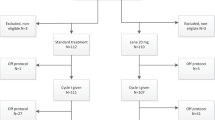Abstract
Acute lymphoblastic leukemia (ALL) in the elderly is characterized by its poor prognosis. Forty patients with ALL, aged 55 years or older, and with good performance status (ECOG <3) were prospectively treated according to an age-adapted regimen: induction therapy was derived from the lala87 protocol while the feasibility of treatment with interferon combined with chemotherapy was assessed during maintenance. compared with younger adults treated according to the lala87 protocol, elderly patients did not present with more adverse prognostic features, except for a lower incidence of t cell all (9 vs 31%, P = 0.005). There were even less patients with a high leukocyte count (15 vs 38%, P = 0.003), a characteristic associated with adverse prognosis while the incidence of Philadelphia-positive (Ph-positive) ALL was not significantly increased compared to younger adults (31 vs 20%, P = 0.2). After completion of induction therapy, with or without salvage treatment, 85% (CI: 70–94%) obtained a complete response (CR) while treatment-related mortality during induction was 7.5% (CI: 2–20%). Median overall survival and disease-free survival were 14.3 months and 14 months, respectively, which, although inferior to results achieved in younger adults, compares favorably with available data in the elderly. Treatment with IFN proved feasible in most patients but had to be discontinued in eight patients because of toxicity. Age-adapted treatment improves the prognosis of ALL in the elderly even if, in most cases, a cure cannot be achieved.
This is a preview of subscription content, access via your institution
Access options
Subscribe to this journal
Receive 12 print issues and online access
$259.00 per year
only $21.58 per issue
Buy this article
- Purchase on Springer Link
- Instant access to full article PDF
Prices may be subject to local taxes which are calculated during checkout
Similar content being viewed by others
Author information
Authors and Affiliations
Rights and permissions
About this article
Cite this article
Delannoy, A., Sebban, C., Cony-Makhoul, P. et al. Age-adapted induction treatment of acute lymphoblastic leukemia in the elderly and assessment of maintenance with interferon combined with chemotherapy. A multicentric prospective study in forty patients. Leukemia 11, 1429–1434 (1997). https://doi.org/10.1038/sj.leu.2400780
Received:
Accepted:
Issue Date:
DOI: https://doi.org/10.1038/sj.leu.2400780
Keywords
This article is cited by
-
Successful diagnosis of veno-occlusive disease caused by inotuzumab ozogamicin through minimal-invasive angiography: a case report
Annals of Hematology (2022)
-
Treatment of Older Patients with Acute Lymphoblastic Leukaemia
Drugs & Aging (2018)
-
The Approach to Acute Lymphoblastic Leukemia in Older Patients: Conventional Treatments and Emerging Therapies
Current Hematologic Malignancy Reports (2016)
-
Successful reintroduction of methotrexate after acute pneumonitis in a patient with acute lymphoblastic leukemia
Annals of Hematology (2003)



